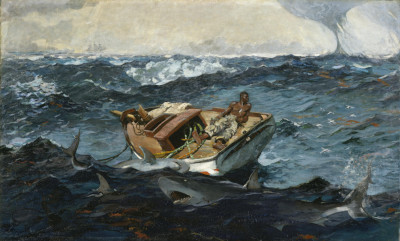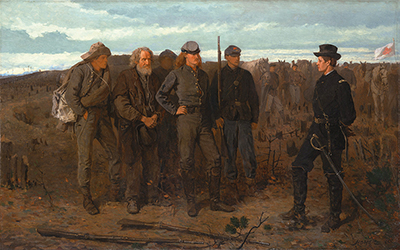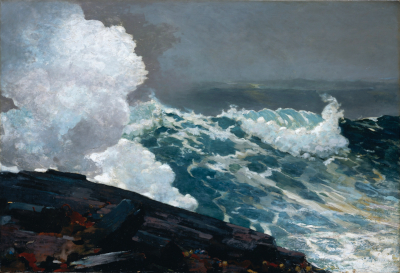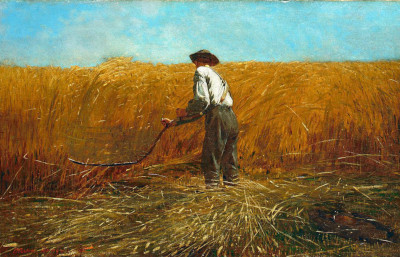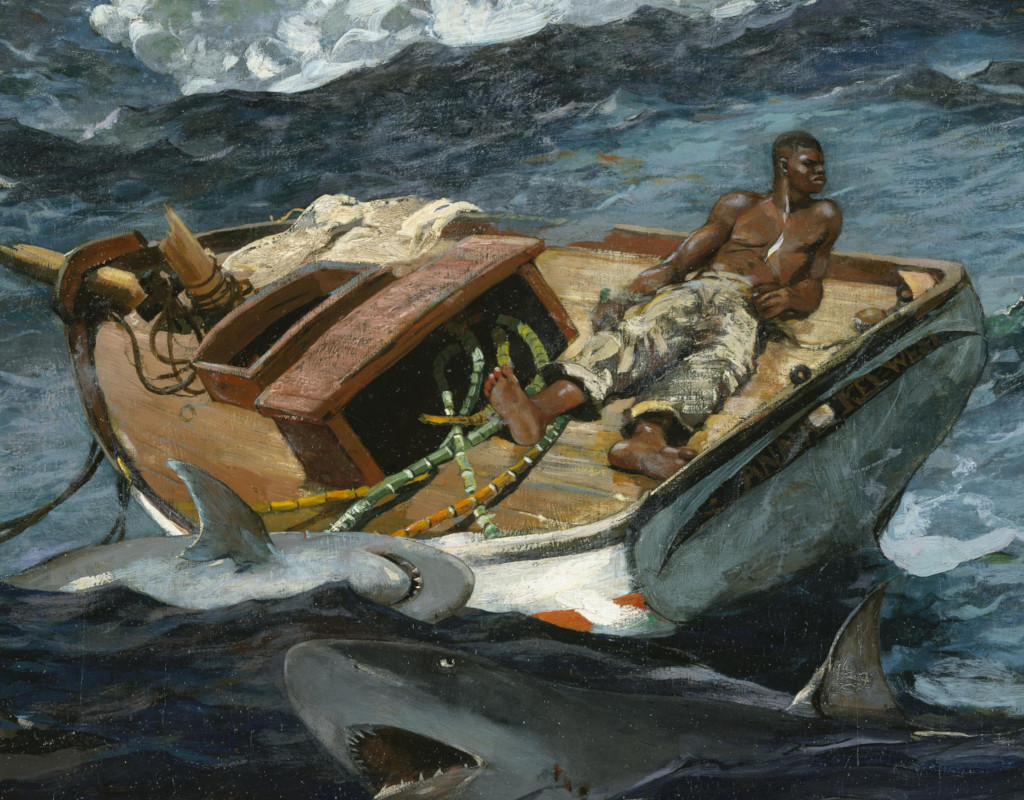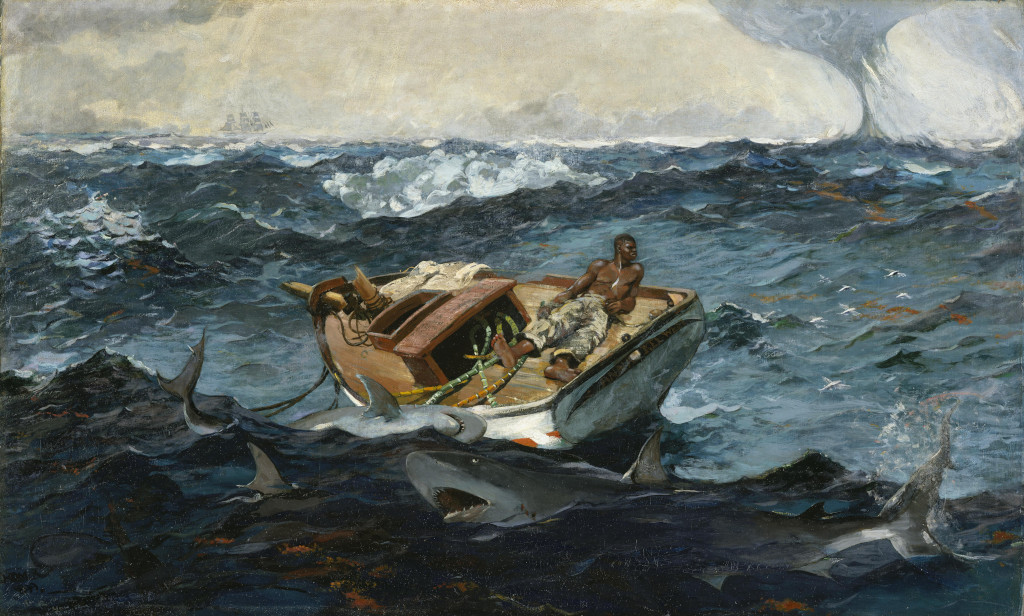The Gulf Stream is a lively seascape painting by American artist, Winslow Homer. He completed this piece in 1899, by which time he would have been in his early to mid sixties and at the peak of his artistic powers.
Introduction
At first glance, The Gulf Stream seems like a standard Winslow Homer painting, with a small boat seen fighting against the forces of nature in the form of a choppy sea. Homer had already produced many seascapes at this point in his career and the tones of colour used here were also particularly familiar. He had chosen to set up his own studio in Maine in order to work in locations such as this without having to travel too far, with some other paintings being completed from the shore line of this stunning American region. He also focused on the lives of ordinary fishermen many times over, often capturing their perilous positions at the mercy of the waves. But The Gulf Stream has another topic lying within it which makes it a particularly important and memorable piece. We find an individual lying on the boat, seemingly in a desperate state. The main sail structure of the boat is been smashed off entirely, leading him staring out to see, seemingly aware of his inevitable fate. Sharks circle around the ship, waiting for their moment.
Description
Whilst the image of someone waiting for their inevitable death can provide enough emotion in the mind of the viewer by itself, it is the connection to other historical crimes which makes this piece particularly harrowing. Clearly, the use of a black man as the figure in question raises a connection to slavery, because of the nature of society at that time, as well as the geographical location of the Gulf Stream itself, which brings a connection to the likes of Florida, Cuba, and the Caribbean. Although the connection is not as definitive as in other artworks, such as Turner's The Slave Ship, one cannot avoid making this leap in our minds. Aside from the role of race in this piece, there is a wonderful display of stoicism in the eyes of many, in how this young man continues to fight for his life, even when faced with such unlikely odds. Some see this piece therefore as romantic, and it does have many similiarities to the French Romancist movement, who themselves did produce a number of impressive seascapes. The current owners of the piece, the Met, have also discussed about how the piece was actually reworked in 1906, a good seven years after the piece was intially completed and exhibited.
Meaning
Most historians believe the role of race here is merely down to the location of this setting, rather than any comment on the brutality of man or the horrors of slavery. Homer himself had visited the Caribbean several times over and became interested in the topic of ship wrecks towards the end of the 19th century. He would actually produce a watercolour in the same year as this piece, titled After the Hurricane, in which another sailor is washed up on the shore after a particularly fierce storm. It was the inclusion of sharks within The Gulf Stream which added an extra layer of desperation, although some critics at the time did not welcome this addition to the painting. They claimed that the creatures looked almost cartoon-like in their expressions, though others applauded the overall piece. The painting itself continues to be studied for a precise meaning today, and viewers will continue to have their own ideas and what precisely is meant by the artist here. One must perhaps put this piece into the context of the artist's other work in 1899, plus his travels in order to understand the piece in front of us here. There is also a tendancy to judge art by today's standards, but this may not be helpful, considering that Winslow Homer himself was born nearly two centuries ago.
Location
The Gulf Stream can be found at The Metropolitan Musuem of Art, New York, USA. It is advertised, at the time of writing, as being on display in Gallery 767 at the main branch, The Met Fifth Avenue. It is listed as having been acquired from the Catharine Lorillard Wolfe Collection, Wolfe Fund in 1906, which was actually the same year in which he re-worked the piece. It's size is mentioned as being (107.5 x 159.3 x 15 cm), including the frame, or 71.4 x 124.8 cm without. It was entirely produced in oils, and this was the first medium in which the artist painted from his early years, before later experimenting successfully with watercolours as well. Sadly, he would only live for around another decade by the time he finished his intial work on this painting, and only four years after his re-working was complete. Thankfully, he had already achieved so much by then that his productive career is now spread across a good number of major American art collections. We do know that Homer sold the piece in 1906 to M. Knoedler and Company, New York and that in the same year it would switch to the Catharine Lorillard Wolfe Collection, Wolfe Fund.
Related Paintings
The Gulf Stream sits within the impressive collection of the Metropolitan Museum of Art and is just one of many artworks by Winslow Homer that can be found here. They are unable to have them all out on display at the same time, because of the sheer size of their overall collection, but the highlights will normally be viewable for those lucky enough to visit this fine art museum. We have included some other exampes of their portfolio further below, and those are also amongst his best known works. Additionally, they have managed to acquire a good breadth of examples from his oeuvre, covering different genres such as portraiture, landscapes and seascapes, but also with regards different mediums, including drawings, works in oil, watercolours and also etchings. Large institutions such as this will also provide greater depth to our knowledge about these artists as they are able to finance studies into the lives of the artists, with a wealth of resources at their disposal. Even on Homer alone, the Met have released several high profile exhibitions, publications and research studies into different aspects of his life.



